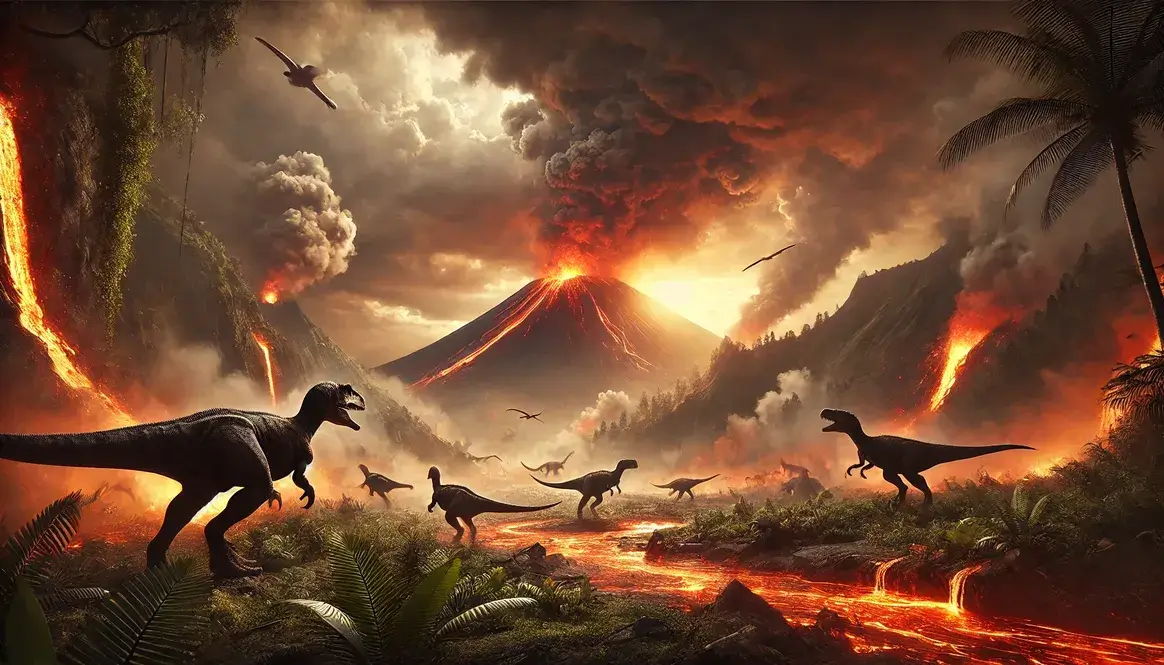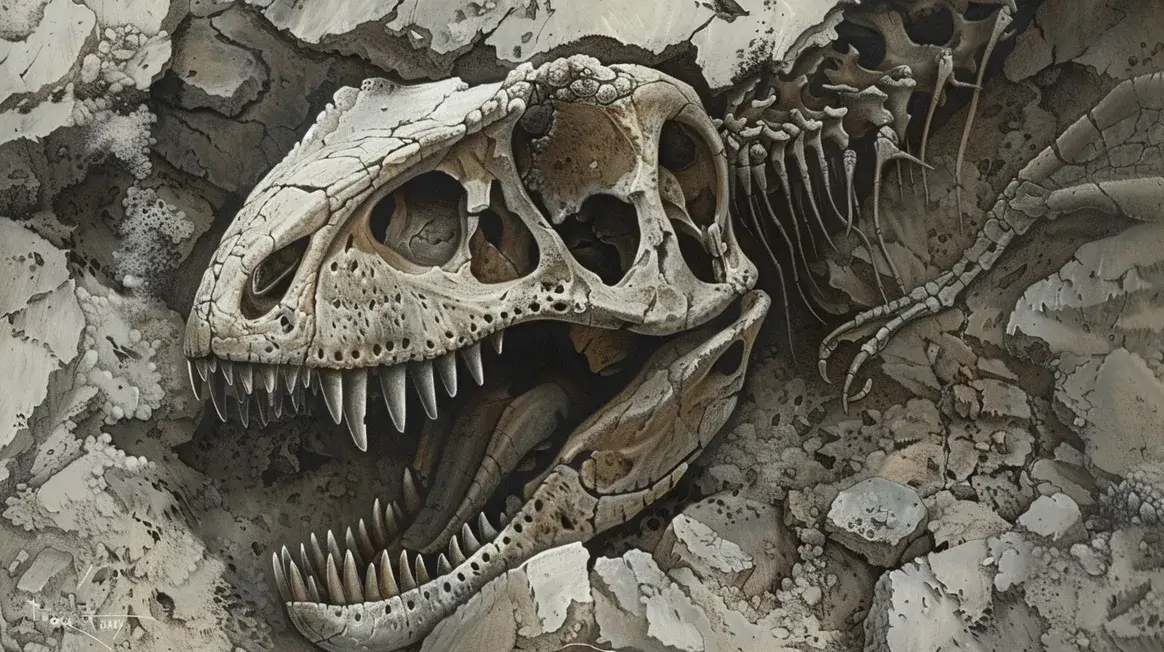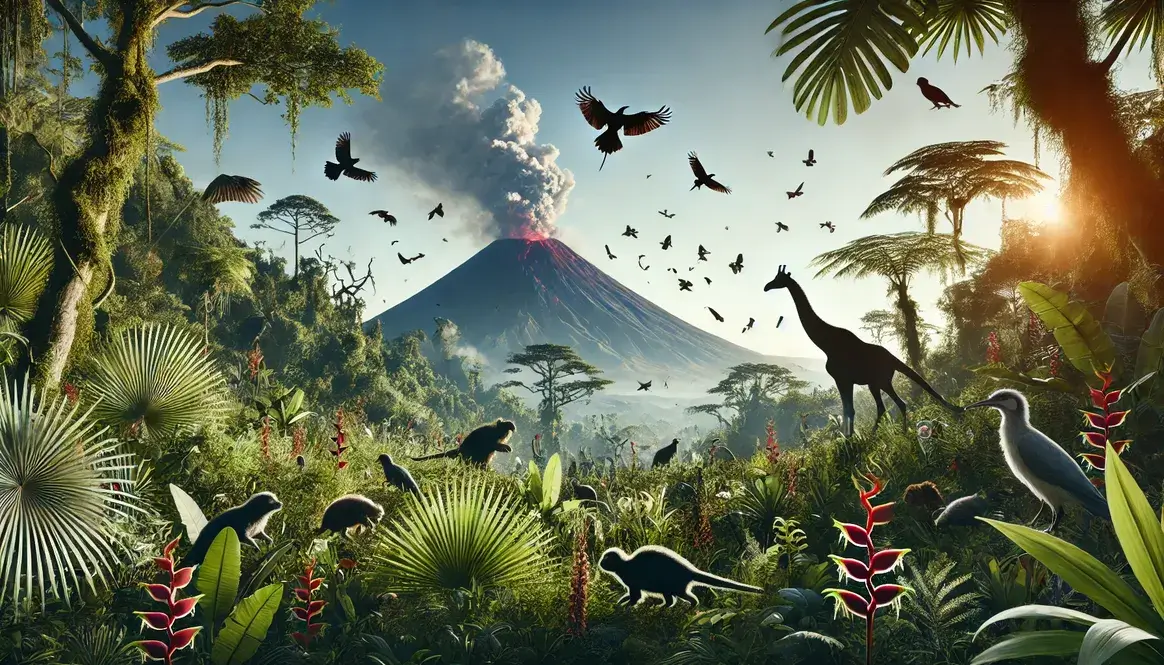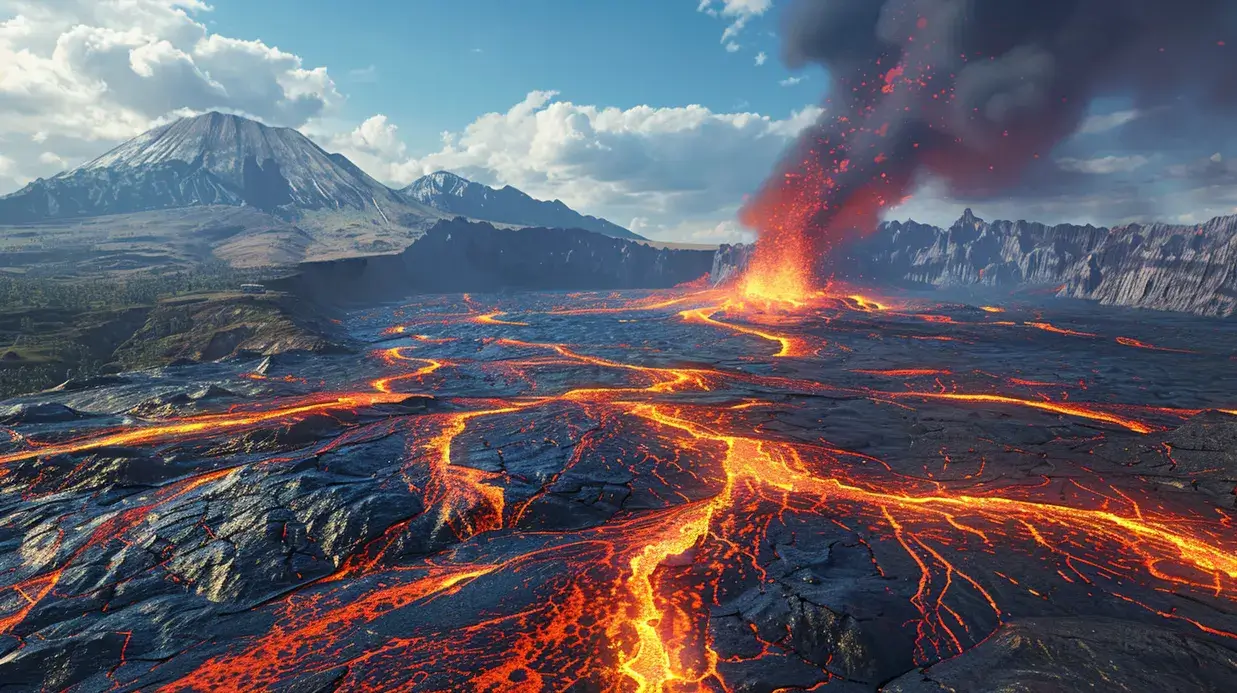The end of the Cretaceous period witnessed a surge in volcanic activity that reshaped our planet’s surface and atmosphere. These powerful eruptions played a significant role in the events leading up to one of Earth’s most famous mass extinctions.
| Key Facts: Volcanoes at end of Cretaceous | Impact on Earth |
|---|---|
| Time period | 66-68 million years ago |
| Major volcanic area | Deccan Traps, India |
| Volcanic activity duration | Approximately 1-2 million years |
| Global temperature change | 2-3°C increase |
| Estimated lava volume | Over 1 million cubic kilometers |
| Effect on dinosaurs | Contributed to their extinction |
The Late Cretaceous World
The Late Cretaceous period, spanning from about 100 to 66 million years ago, was a time of great change on Earth. Dinosaurs ruled the land, while strange and fascinating creatures swam in the seas. The world looked very different from what we know today.
During this time, the continents were still moving apart due to plate tectonics. North America and Europe were separating, creating the early Atlantic Ocean. India was an island, slowly drifting northward towards Asia. This movement of Earth’s crust set the stage for intense volcanic activity.
The climate was warmer than today, with no polar ice caps. Lush forests covered much of the land, even in areas that are now deserts. This warm, humid world was about to face a series of dramatic changes.
Volcanoes at end of Cretaceous: A Global Phenomenon
As the Cretaceous period neared its end, about 66 million years ago, volcanic eruptions began to increase dramatically around the world. This wasn’t just a few volcanoes here and there – it was a global phenomenon that would have profound effects on the planet.
The volcanoes at end of Cretaceous were more active and widespread than at any other time in the dinosaurs’ reign. But why did this happen?
The answer lies deep within the Earth. The movement of tectonic plates caused increased pressure and heat in certain areas, leading to more frequent and intense eruptions. The most significant of these was the formation of the Deccan Traps in what is now India.
But the Deccan Traps weren’t alone. Volcanic activity increased across the globe:
- In North America, volcanoes erupted along the western coast.
- In Europe, underwater volcanoes became more active.
- The Pacific Ring of Fire saw increased activity, with eruptions in what are now Japan and the Philippines.
This global increase in volcanism had far-reaching effects. It released huge amounts of gases and particles into the atmosphere, changing the climate and affecting life across the planet. The stage was set for one of the most dramatic periods in Earth’s history, with volcanoes playing a starring role.
Early Signs: Volcanic Activity in the Mid-Cretaceous
The story of the volcanoes at end of Cretaceous didn’t begin suddenly. In fact, the Earth had been showing signs of increased volcanic activity for millions of years before the big finale.
During the Mid-Cretaceous period, about 100 million years ago, our planet started to rumble more frequently. This wasn’t just a few isolated incidents – it was the beginning of a global trend. Here’s what was happening:
- Underwater volcanoes became more active, especially in the Pacific Ocean.
- Large igneous provinces (areas of extensive volcanic rock) began to form in various parts of the world.
- The frequency of volcanic eruptions gradually increased over time.
These early signs were like whispers of what was to come. The Earth was slowly building up to a volcanic crescendo that would shake the foundations of life itself.
One of the most significant events during this time was the formation of the Ontong Java Plateau, an enormous underwater volcanic plateau in the Pacific Ocean. This massive eruption covered an area roughly the size of Alaska and was a hint of the scale of volcanism to come.
As time went on, these volcanic events became more frequent and more intense. The Earth’s crust was becoming increasingly unstable, setting the stage for the dramatic events at the end of the Cretaceous period.
The Deccan Traps: A Massive Eruption Begins
Fast forward to about 66 million years ago, and we arrive at one of the most spectacular volcanic events in Earth’s history: the formation of the Deccan Traps.
The Deccan Traps eruption began in what is now western India. But this wasn’t just any ordinary volcanic eruption. Imagine a volcano so massive that it could cover an area larger than the state of Texas in lava over a million feet deep. That’s the scale we’re talking about with the Deccan Traps.
| Deccan Traps Facts | Details |
|---|---|
| Location | Western India |
| Area covered | Over 500,000 square kilometers |
| Lava volume | Estimated 1,000,000 cubic kilometers |
| Duration | Approximately 1-2 million years |
| Type of volcanism | Flood basalt |
The initial phases of the eruption were intense. Fissures in the Earth’s crust opened up, releasing enormous amounts of lava. This wasn’t the kind of volcano you might picture with a cone-shaped mountain. Instead, the ground split open, and lava poured out across the landscape.
The effects were immediate and far-reaching:
- The landscape was transformed, buried under layers of basalt rock.
- Huge amounts of gases and particles were released into the atmosphere.
- The local ecosystem was devastated, with plants and animals struggling to survive.
But this was just the beginning. The Deccan Traps eruption would continue for hundreds of thousands of years, pumping more and more lava and gases into the environment. Its effects would be felt not just in India, but across the entire planet, contributing to the dramatic changes that marked the end of the Cretaceous period.
Worldwide Volcanic Activity Intensifies
As the Cretaceous period neared its end, the Earth seemed to be going through a volcanic growth spurt. The Deccan Traps weren’t the only show in town. Volcanoes around the world were waking up, creating a global spectacle of fire and ash.
The frequency and magnitude of eruptions increased dramatically. It was as if the planet had decided to redecorate itself with a new layer of lava. This worldwide volcanic activity had far-reaching consequences, altering landscapes, climates, and the very air that dinosaurs breathed.
North American Volcanism
North America wasn’t left out of this geological party. The Western Interior Seaway, a vast inland sea that split the continent in two, became a hotbed of volcanic activity.
- Laramide Orogeny: This mountain-building event triggered increased volcanism in the western United States.
- Volcanic ash layers: Geologists have found numerous ash layers in rock formations from this time, evidence of frequent eruptions.
- Impact on dinosaurs: These eruptions affected local dinosaur populations, altering their habitats and food sources.
The volcanoes affected evolution of North American species, pushing them to adapt or face extinction.
European Volcanic Events
Europe, too, experienced its share of fiery drama. While not as extensive as the Deccan Traps, European volcanic events played their part in the end-Cretaceous story.
- Underwater volcanoes: Many eruptions occurred beneath the seas that covered parts of what is now Europe.
- Tethys Ocean: Volcanic activity was particularly intense along the margins of this ancient ocean.
- Atmospheric impact: These eruptions contributed to the global changes in climate and air quality.
Pacific Ring of Fire Activity
The Pacific Ring of Fire, a horseshoe-shaped belt of volcanic activity encircling the Pacific Ocean, was particularly active during this time. This region, known for its earthquakes and volcanoes even today, was a major player in the end-Cretaceous volcanic drama.
| Pacific Ring of Fire Activity | Effects |
|---|---|
| Increased number of eruptions | More frequent earthquakes and tsunamis |
| Larger magnitude eruptions | Greater amounts of ash and gases released into atmosphere |
| Submarine volcanism | Changes in ocean chemistry and temperature |
The increased activity along the Pacific margins had global consequences. It contributed to climate change, altered ocean currents, and affected marine life. The volcanic ocean acidity increased, making life difficult for many sea creatures.
This worldwide intensification of volcanic activity set the stage for the dramatic climatic and environmental changes that would follow. The Earth was entering a new phase, one that would ultimately lead to the end of the age of dinosaurs.
Peak Volcanic Activity: The Final Years of the Cretaceous
As the curtain began to fall on the Cretaceous period, the Earth entered a phase of volcanic activity unlike anything seen before. The final years, spanning roughly 100,000 to 300,000 years before the end of the Cretaceous, were marked by an extraordinary intensification of global volcanism.
During this time, the Deccan Traps eruptions reached their zenith. Lava poured from fissures in the Earth’s crust at an unprecedented rate, covering vast swathes of land in what is now India. But the Deccan Traps were just one part of a larger, global volcanic crescendo.
Here’s a snapshot of the volcanic activity during this intense period:
- Deccan Traps (India): The main event, releasing massive amounts of lava and gases.
- North America: Increased activity along the western coast and in the Rocky Mountain region.
- Europe: Underwater volcanoes in the Tethys Ocean intensified their eruptions.
- Pacific Ring of Fire: A dramatic uptick in both terrestrial and submarine volcanism.
- Africa: Volcanic activity increased in what is now Ethiopia and Kenya.
The global distribution of these eruptions meant that no part of the Earth was left untouched by their effects. Ash and gases were pumped into the atmosphere at an alarming rate, leading to rapid and severe changes in climate.
| Region | Major Volcanic Activity |
|---|---|
| India | Deccan Traps flood basalts |
| North America | Western coast and Rocky Mountain eruptions |
| Europe | Underwater volcanoes in Tethys Ocean |
| Pacific Rim | Increased activity along Ring of Fire |
| Africa | Eruptions in East Africa |
This peak in volcanic activity had far-reaching consequences. The volcanic winter phenomenon became a reality, with ash and gases blocking out sunlight and causing global cooling. At the same time, greenhouse gases from the eruptions led to periods of intense warming.
The sheer scale of volcanism during this time is hard to comprehend. If we could travel back in time to these final years of the Cretaceous, we would see a world in turmoil. The sky would often be dark with ash, the air thick with volcanic gases. The landscape would be constantly changing as lava flows created new terrain and destroyed old habitats.
This period of peak volcanic activity set the stage for the dramatic events that would follow. The Earth’s systems were pushed to their limits, creating an environment of extreme stress for the creatures that called this world home. The age of dinosaurs was coming to an end, and volcanoes were playing a starring role in this planetary drama.
Environmental Effects of Late Cretaceous Volcanism
The intense volcanic activity at the end of the Cretaceous period didn’t just change the landscape – it transformed the entire planet. From the air to the oceans, from the poles to the equator, the effects of these eruptions were felt everywhere. Let’s explore how these fiery events reshaped our world.
In the short term, each eruption caused immediate, localized changes. Ash fell from the sky, smothering plants and making it hard for animals to breathe. Rivers of lava reshaped landscapes, destroying habitats and forcing creatures to migrate or adapt.
But it’s the long-term effects that truly showcase the power of these volcanoes. Over thousands of years, the cumulative impact of countless eruptions led to global changes that would have been unimaginable to the dinosaurs roaming the Earth.
Atmospheric Changes
The atmosphere took the brunt of the volcanic assault. With each eruption, a cocktail of gases and particles was launched into the sky. Here’s what was happening up there:
- Carbon dioxide: This greenhouse gas was released in enormous quantities, trapping heat in the atmosphere.
- Sulfur dioxide: When this gas combines with water in the atmosphere, it forms acid rain.
- Ash and dust: Tiny particles blocked sunlight, leading to cooling effects.
The release of these materials didn’t just stay in one place. Wind currents spread them across the globe, affecting areas far from the eruption sites. The volcanic ash in fossils from this time period provides evidence of just how widespread these effects were.
Global Cooling and Warming Cycles
The climate during this time was like a roller coaster, with dramatic ups and downs in temperature. These fluctuations were largely driven by volcanic activity.
- Cooling Phases: When large amounts of ash and sulfur dioxide were ejected into the upper atmosphere, they blocked sunlight, causing global cooling.
- Warming Phases: As the ash settled, the greenhouse gases (mainly CO2) remained in the atmosphere, trapping heat and causing warming.
These cycles could happen relatively quickly, possibly within a few human lifetimes. Imagine being a dinosaur trying to adapt to these rapid changes!
| Phase | Cause | Effect |
|---|---|---|
| Cooling | Ash and sulfur dioxide in atmosphere | Global temperatures drop |
| Warming | Greenhouse gases accumulate | Global temperatures rise |
Changes in Rainfall Patterns
The volcanoes didn’t just affect temperature – they also changed how and where it rained. The altered atmosphere led to significant shifts in global precipitation patterns.
- Increased Rainfall: In some areas, the particles in the air acted as nuclei for raindrops, leading to more frequent and intense rainfall.
- Droughts: Other regions experienced prolonged dry spells as normal weather patterns were disrupted.
- Acid Rain: The sulfur dioxide released by volcanoes led to acid rain, which could damage plants and acidify water bodies.
These changes in rainfall had a profound impact on ecosystems. Plants that were adapted to certain amounts of rainfall suddenly found themselves in a very different world. This, in turn, affected the herbivores that depended on these plants, and the carnivores that hunted the herbivores.
The environmental effects of Late Cretaceous volcanism were complex and far-reaching. They set in motion a chain of events that would ultimately contribute to one of the most significant mass extinctions in Earth’s history.
Impact on Cretaceous Ecosystems
The volcanic activity at the end of the Cretaceous period didn’t just change the physical landscape – it completely transformed the living world. From the tiniest plants to the mightiest dinosaurs, no organism was left untouched by these dramatic events.
Let’s start with the plants. They were the foundation of Cretaceous ecosystems, and they took a major hit from the volcanic activity. The ash and gases released by the eruptions made life difficult for many plant species:
- Sunlight was blocked, reducing photosynthesis
- Acid rain damaged leaves and contaminated soil
- Temperature changes stressed many species
Some plants adapted to these harsh conditions, while others couldn’t survive. This led to significant changes in the vegetation across the globe. Forests that once teemed with life became sparser, and some areas might have turned into barren wastelands.
Changes in Animal Habitats
As the plant life changed, so did the habitats of the animals that depended on them. The Deccan Traps effect on ancient life was profound, altering environments across the globe.
Dinosaurs, who had ruled the Earth for millions of years, found their world changing rapidly:
- Forest dwellers: As forests thinned out, dinosaurs that lived in dense vegetation had to adapt or move.
- Grassland inhabitants: Areas that were once open plains might have become more forested as different plants took over.
- Coastal species: Rising sea levels from melting ice caps flooded some coastal areas, shrinking habitats.
Imagine a T. rex trying to hunt in a forest that’s half the size it used to be, or a long-necked sauropod struggling to find enough vegetation to sustain its massive body. These were the challenges faced by the last dinosaurs.
Food Chain Disruptions
The changes in plant life and habitats had a domino effect on the entire food chain. It was like a game of Jenga, where removing one piece can make the whole tower wobble.
| Trophic Level | Impact of Volcanic Activity |
|---|---|
| Producers (Plants) | Reduced in number and diversity |
| Primary Consumers (Herbivores) | Food sources became scarce |
| Secondary Consumers (Carnivores) | Prey animals became harder to find |
Here’s how the disruptions played out:
Herbivores: With less plant life available, herbivorous dinosaurs had to compete more fiercely for food. Some may have had to travel farther to find enough to eat, exposing themselves to new dangers.
Carnivores: As herbivore populations decreased or moved, carnivores had to adapt their hunting strategies. Some might have had to switch to different prey or risk starvation.
Even the smallest disruptions could have big consequences. For example, if certain plants became scarce, the insects that pollinated them might have died out. This could then affect the small animals that ate those insects, and so on up the food chain.
The volcanic activity at the end of the Cretaceous didn’t just make life harder for individual animals – it rewrote the rules of the entire ecosystem. These changes, happening over thousands of years, set the stage for the dramatic events that would follow, ultimately leading to the end of the age of dinosaurs.
The Final Blow: Volcanism and the K-Pg Extinction Event
The story of the dinosaurs’ extinction is a scientific thriller, with volcanoes playing a crucial role. But were they the main culprit or just an accomplice? Let’s explore the relationship between volcanic activity and the K-Pg extinction event.
Volcanic eruptions, particularly the Deccan Traps, had been reshaping the Earth for hundreds of thousands of years. They created a world of stress for many species:
- Altered climate
- Changed landscapes
- Disrupted food chains
But then came the asteroid. About 66 million years ago, a massive space rock slammed into what is now the Yucatan Peninsula in Mexico. This impact, combined with the ongoing volcanic activity, delivered the final blow to many Cretaceous species, including most dinosaurs.
So, which was more important – the volcanoes or the asteroid? Scientists have been debating this for years. Here’s a simplified view of the argument:
Team Volcano:
- Long-term stress on ecosystems
- Gradual climate change
- Weakened species more vulnerable to extinction
Team Asteroid:
- Sudden, catastrophic event
- Global darkness and cooling
- Widespread fires and tsunamis
The truth? It was likely a combination of both. The Deccan Traps’ role in dinosaur extinction is still debated, but many scientists now believe that the volcanoes set the stage, and the asteroid delivered the knockout punch.
Studying Ancient Volcanoes: Clues in the Rocks
But how do we know all this? How can scientists peer back in time to understand events that happened millions of years ago? The answer lies in the rocks beneath our feet.
Geologists are like detectives, searching for clues left behind by ancient volcanoes. Here are some of the methods they use:
- Radiometric dating: This technique helps determine the age of volcanic rocks.
- Chemical analysis: The composition of rocks can reveal details about ancient eruptions.
- Fossil studies: Fossils found in volcanic ash can provide information about the impact on life.
One particularly interesting line of evidence comes from mercury. The K-Pg mercury pollution left traces that scientists can detect today, giving us insights into the scale of volcanic activity.
Understanding these ancient volcanoes is crucial for piecing together the puzzle of the end-Cretaceous events. They provide context for the changes that were happening on Earth before, during, and after the asteroid impact.
| Evidence Type | What It Tells Us |
|---|---|
| Volcanic rock layers | Timing and extent of eruptions |
| Ash deposits | Spread of volcanic material |
| Fossilized plants | Changes in vegetation |
| Chemical signatures | Composition of volcanic gases |
Scientists are continually refining their methods and making new discoveries. For example, computer models of the Deccan Traps help visualize how these massive eruptions might have affected global climate.









